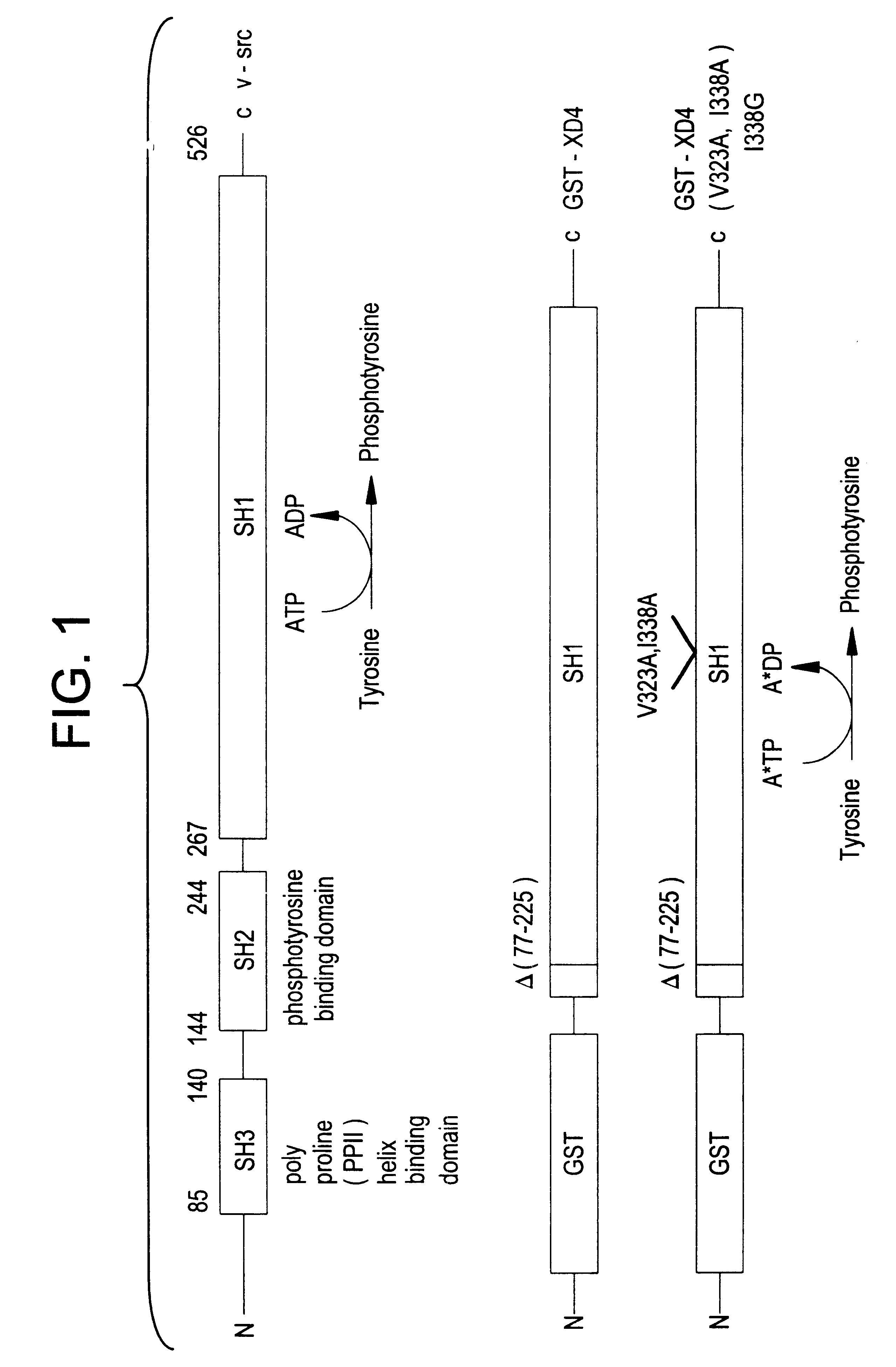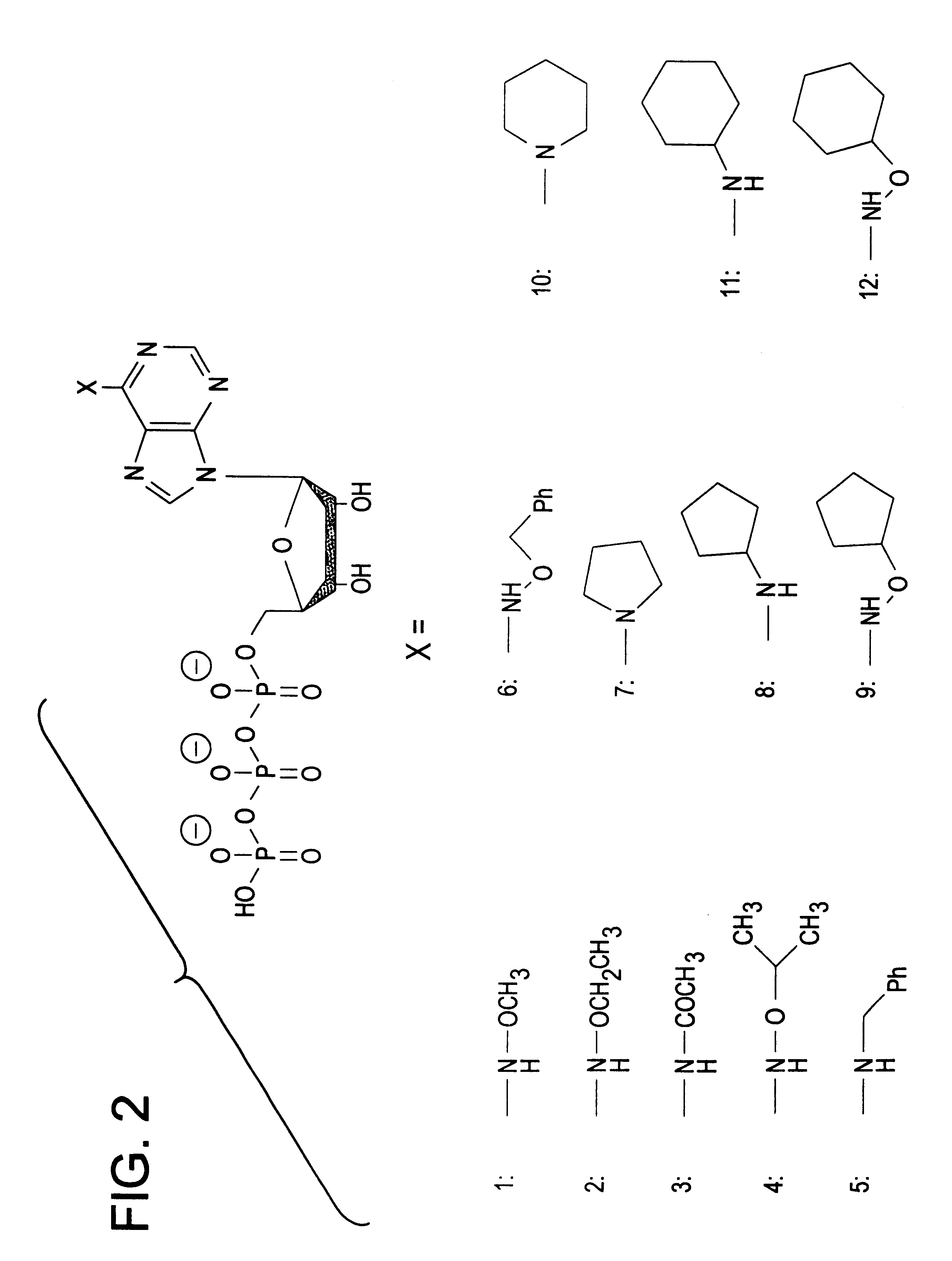Engineered protein kinases which can utilize modified nucleotide triphosphate substrates
- Summary
- Abstract
- Description
- Claims
- Application Information
AI Technical Summary
Benefits of technology
Problems solved by technology
Method used
Image
Examples
example 10
provides one example of a method of using a mutant kinase of the present invention, along with its orthogonal substrate analog or its inhibitor, as the case may be, to detect which are the intracellular protein substrates for that protein kinase. Developing such a test was a primary goal of the research that led to the present invention.
Generally, the method described in Example 10 and in FIG. 8 would appear to be generally applicable; however, there are many other possible approaches that could be used, once a mutant that accepts an orthogonal substrate analog or inhibitor has been prepared. The natural phosphate donor substrate is first prepared to contain a labeled moiety on the terminal phosphate, for example, by replacing the phosphate with [.gamma.-.sup.32 P] phosphate. This substrate, along with the analog or inhibitor, is then added to a sample of lysed cells, cell extracts, permiabilized cells, or cells which are naturally permeable to the orthogonal nucleotide triphosphate...
example 1
Synthesis of ATP analogs
Twelve different orthogonal ATP analogs were synthesized. FIG. 2 is a schematic representation of their structure. The figure shows adenosine triphosphate (ATP), with an "X" bound to the 6 position; and in the box below, schematic representations are provided for the twelve side chains that take the place of "X" in each of the orthogonal ATP analogs described in the examples (which are always referred to by the numbers 1-12 set forth in bold typeface). Those analogs are:
Analogs 1, 2, 4, 6, 9 & 12 were synthesized via Dimroth rearrangement of the corresponding N.sup.1 alkoxy adenine derivatives in four steps starting from adenosine, according to the procedure of Fuji et al. (43). Analog 5 was synthesized similarly via Dimroth rearrangement of N.sup.1 benzyladenosine (44). Analog 3 was prepared via in situ protection of the adenosine hydroxyl groups as trimethylsilyl ethers and subsequent treatment with acetyl chloride, according to McLaughlin et al. (45). Anal...
example 2
Screening of Nucleotide Analogs
To identify compounds that would not be accepted as substrates by any existing cellular kinases (53), Applicant screened a panel of synthetic A*TP analogs in a murine lymphocyte lysate (CF) rich in protein tyrosine kinases (13).
The assays were performed using spleenocytes (8-30 week old male and female C57 / B6 mice from the Princeton University Animal Facility) which were isolated and washed in RPMI-1640 medium containing 5% Bovine Calf Serum (BCS), 1% Hepes and DNaseI (1 .mu.g / ml). Red cells were lysed at 4.degree. C. by treatment with 17 mM Tris ammonium chloride (pH 7.2). The cells were hypotonically lysed on ice for ten minutes in 1 mM Hepes (pH 7.4), 5 mM MgCl.sub.2, leupeptin (10 .mu.g / ml), aprotinin (10 .mu.g / ml) and 100 .mu.M PMSF according to the method of Fukazawa et al. (51). After vortexing and centrifugation at 500.times.g, the supernatant was collected. Cells were stored at 4.degree. C. for twenty minutes to attenuate the basal protein ph...
PUM
| Property | Measurement | Unit |
|---|---|---|
| Angle | aaaaa | aaaaa |
| Angle | aaaaa | aaaaa |
Abstract
Description
Claims
Application Information
 Login to View More
Login to View More - R&D
- Intellectual Property
- Life Sciences
- Materials
- Tech Scout
- Unparalleled Data Quality
- Higher Quality Content
- 60% Fewer Hallucinations
Browse by: Latest US Patents, China's latest patents, Technical Efficacy Thesaurus, Application Domain, Technology Topic, Popular Technical Reports.
© 2025 PatSnap. All rights reserved.Legal|Privacy policy|Modern Slavery Act Transparency Statement|Sitemap|About US| Contact US: help@patsnap.com



